Studio Visit
In Her Maine Studio, Anne Buckwalter Paints Playfully Provocative Domestic Scenes, Breaking to Feed Chickens and Pick Blueberries
The artist's solo exhibition "Reins on a Rocking Horse" is currently on view at Rachel Uffner in New York.
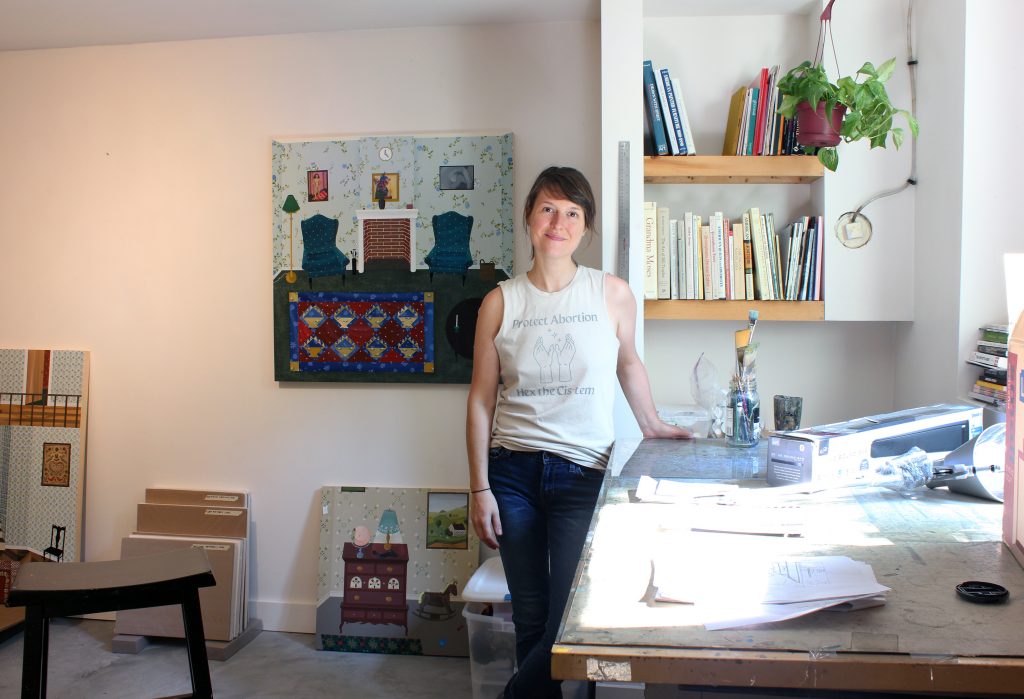
The artist's solo exhibition "Reins on a Rocking Horse" is currently on view at Rachel Uffner in New York.

Katie White

Anne Buckwalter’s studio is a room with many painted rooms within it. The artist, who recently moved to Maine, is known for her flattened and precise interior spaces that meld the vernacular of the Pennsylvania Dutch folk art tradition with the accouterments of contemporary life. There is more than first meets the eye playing out in these astute compositions, however. Oftentimes, carnal interludes are hiding in plain sight.
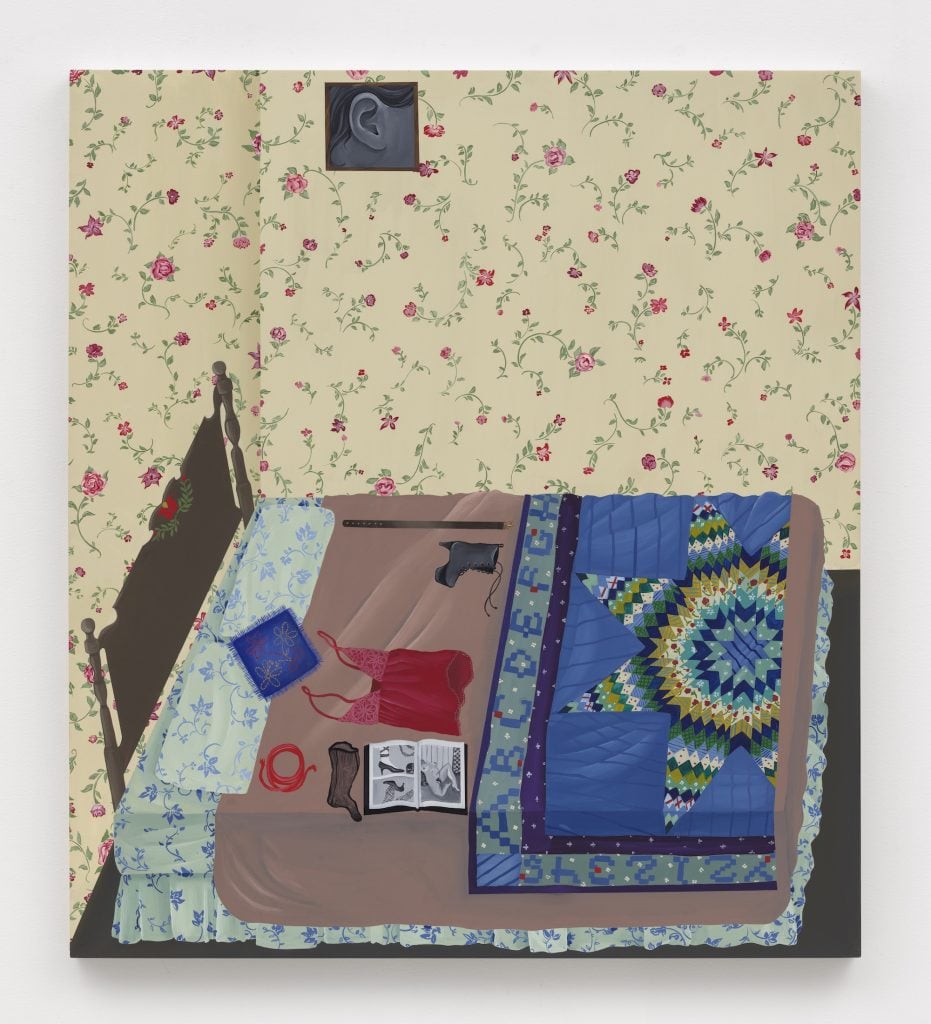
Anne Buckwalter, Good Listener (2023). Photograph by JSP Art Photography. Courtesy of Rachel Uffner, New York.
In one new work, Good Listener, currently on view in “Reins on a Rocking Horse”—the artist’s second solo exhibition with Rachel Uffner in New York—a seemingly quaint bedroom bursts with folksy patterns like a blue quilted bedspread, riotously floral wallpaper, and a painted headboard. But look closely at the objects strewn across the bed—a black silk stocking, an illicit magazine spread open, a twist of red rope—and the homey space inverts unexpectedly into a kinky boudoir in disguise. In other works, mirrors reflect cuts of naked skin, while chairs and cabinets stand as silent witnesses to the household.
Buckwalter, who grew up in Pennsylvania, creates these unexpectedly provocative gouache works in a home studio. Her cat Hoagie is her only studio companion as Buckwalter much prefers to work in isolation.
As Buckwalter was putting the finishing touches on her show at Rachel Uffner, we caught up with the artist to talk about foraging for blueberries, searching for toads, and yes, painting in her studio.
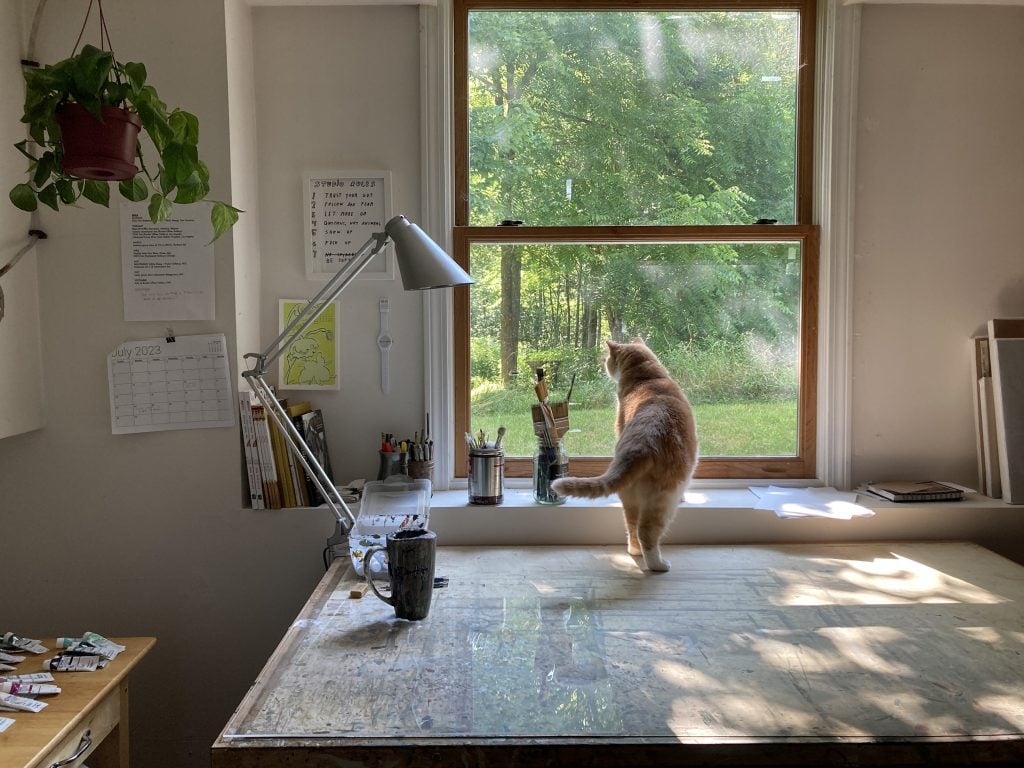
“My cat, Hoagie, watching the chickadees.”
Tell us about your studio.
Right now, my studio is a room in my home. My partner and I recently bought a house and a bit of land in rural Maine, and I’m planning to build a separate studio on the property, but until that happens I’m working in the house. The space is small and cheery; the window overlooks a wildflower patch and a grove of pines.
What made you choose this particular studio over others?
When we moved here I thought about renting a space in Brunswick, which is the closest town and has a lively artist community. But working at home really suits me—I love being at the house, and I’m kind of always non-stop working. I like being able to shuffle into my studio in my bathrobe at weird hours or work on a painting while there’s a cake in the oven. I like having my work as close to me as possible, at all times.
I’ve moved around a lot and rented a bunch of studio spaces over the years, but I started painting at home during the high days of the pandemic when I couldn’t get to my studio. It’s become really important to me to maintain an adaptable studio practice, one that isn’t dependent on specific spatial conditions. My needs are pretty minimal, and I like to keep it that way so I can always make work, even if my circumstances shift. Because they have, and frequently. Even if you feel deeply rooted somewhere, things can always change.
I’m skeptical of the romanticization of the studio—I don’t buy into the notion that the size or look of an artist’s studio necessarily correlates to how serious they are about their practice. The work is what matters. Having access to a nice big studio is great, and a privilege, but I think it can be dangerous for that to evolve into a requirement. For me anyway.
Do you have studio assistants or other team members working with you? What do they do?
God no. I can’t imagine having assistants. I’m very solitary, and a control freak, and would probably make a terrible delegator.
How many hours do you typically spend in the studio, what time of day do you feel most productive, and what activities fill the majority of that time?
It’s hard to quantify the time I spend in the studio because I’m sort of in and out of there all day. But I especially love working in the early hours. I typically wake up around six or seven, make coffee, head into the studio, and stare at whatever I painted the day before while I rejoin the waking world. Then I’ll make something for breakfast and eat while I do some reading or writing, processing what I want to work on that day. I’ll actually get to painting by mid-morning at the latest. I’ll usually paint until 6 or 7 in the evening, sometimes later. I take a lot of breaks though—I’ll go for a jog, write emails, feed my chickens, or wander around in the forest.
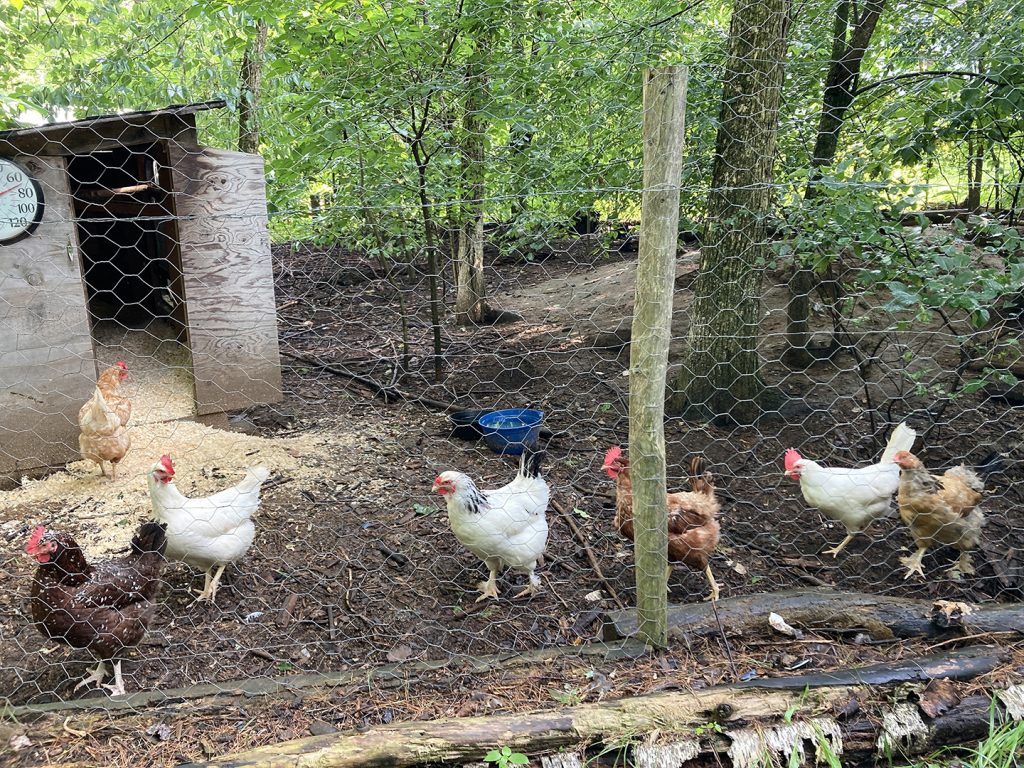
“Here are my chickens, all named after drag queens.”
What is the first thing you do when you walk into your studio (after turning on the lights)?
Maybe this is embarrassing: I say thank you. I feel so grateful to be working as a painter. For a long time, I worked a 9-to-5 job while also keeping a full-time studio practice, and being able to just be in the studio every day right now is incredibly dreamy. It’s heaven.
What are you working on right now? Please send us a few smartphone shots of a work in progress—or photos of different works in various states of completion—in a way that you think will provide insight into your process.
I just finished a group of paintings and drawings for my solo show with Rachel Uffner Gallery, so right now my studio is unusually, gloriously, pretty sparse. I like this time of recalibration—when you’ve spent so long preparing a body of work, and then it leaves the studio, and there’s that punctuation of an end of something and a clean sense of starting over. It is holy and a bit terrifying. I do have some things in progress though, because I’m always working on like three or four paintings at a time. I am preparing for two shows next spring—one with Sarah Miska at Micki Meng, and a solo project at Massimo de Carlo Pièce Unique—so I’m starting to churn out some ideas for those.
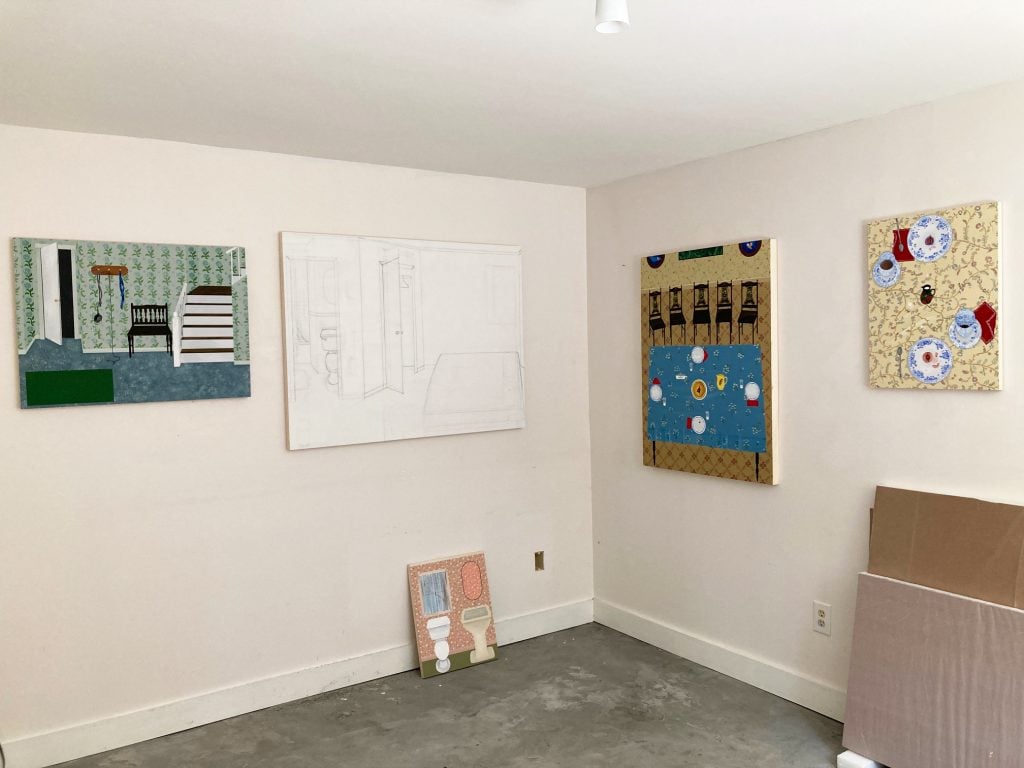
Paintings in various stages of completion at Buckwalter’s studio.
What kind of atmosphere do you prefer when you work? Is there anything you like to listen to/watch/read/look at etc. while in the studio for inspiration or as ambient culture?
It depends on what I’m working on. I’ll put on spare instrumental music, like Nils Frahm, Ryuichi Sakamoto, or Arvo Pärt when I’m doing something that requires deep concentration, or when I’m starting something new and it’s not born yet. Once a painting is underway and I have the composition more or less mapped out, I usually listen to podcasts while I’m working. Some of my favorites are Bodies, Las Culturistas, Savage Love, You Are Good, Death Sex and Money, Everyday Decisions with Jo Firestone, and the New Yorker Fiction Podcast. I also listen to The Daily or other news shows when I don’t mind being bummed out.
How do you know when an artwork you are working on is clicking? How do you know when an artwork you are working on is a dud?
I don’t think I can explain it articulately. That’s the supernatural mystery of painting, right? The painting is always in a conversation with you and it has a life of its own. Sometimes I can feel really confident about how something is progressing, and it’s only when I’m 95 percent finished with it that I realize it’s not right. What a hilarious moment. I love being tricked by a painting, being reminded I’m not as in control as I thought. I think so much of growing as a painter depends on locating the courage to make stuff you don’t like, to fumble around in the inner dark, and then reorient yourself after a lot of errors. It’s why “fuck up” is on my list of studio rules—it truly is a necessary part of the process. I paint over stuff a lot. It probably doesn’t look like it because my paintings are orderly, but I often make sudden, impulsive decisions, and they regularly go awry, and sometimes they work miraculously. This is what I love most about painting—its inexplicability, its unpredictable ways of teaching me things about the world, and about how I move through it. I’m always in service of its lessons rather than the other way around.
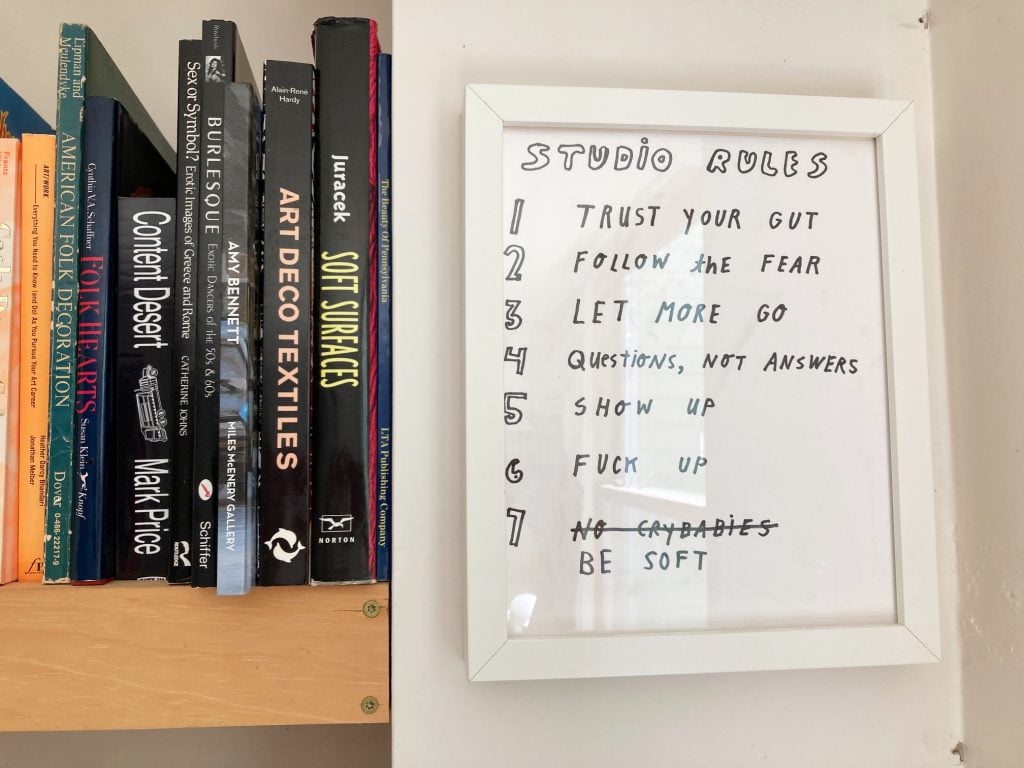
“These are the rules! Crying is now allowed.”
When you feel stuck while preparing for a show, what do you do to get unstuck?
There’s this project that Brian Eno did with Peter Schmidt back in the ’70s called Oblique Strategies. It’s a deck of oracle cards that are meant to guide you through creative ruts. The prompts are poetic and ambiguous, like “Repetition is a form of change” or “Ask your body” or “When is it for?” I love them so much. The original edition is rare and I think hard to get, but I got a bootlegged version as a PDF from my friend Liz years ago. When I feel stuck, I shuffle the deck, pull a card, and let that dictate what happens next. The most recent one I pulled, when I was struggling to figure out how to organize the composition of a big painting, said, “Go to an extreme, move back to a more comfortable place.” So I made myself tussle with this large painting. And then once I got it to a place that felt good, I started working on a very small painting, and it felt like approaching it from a new angle.
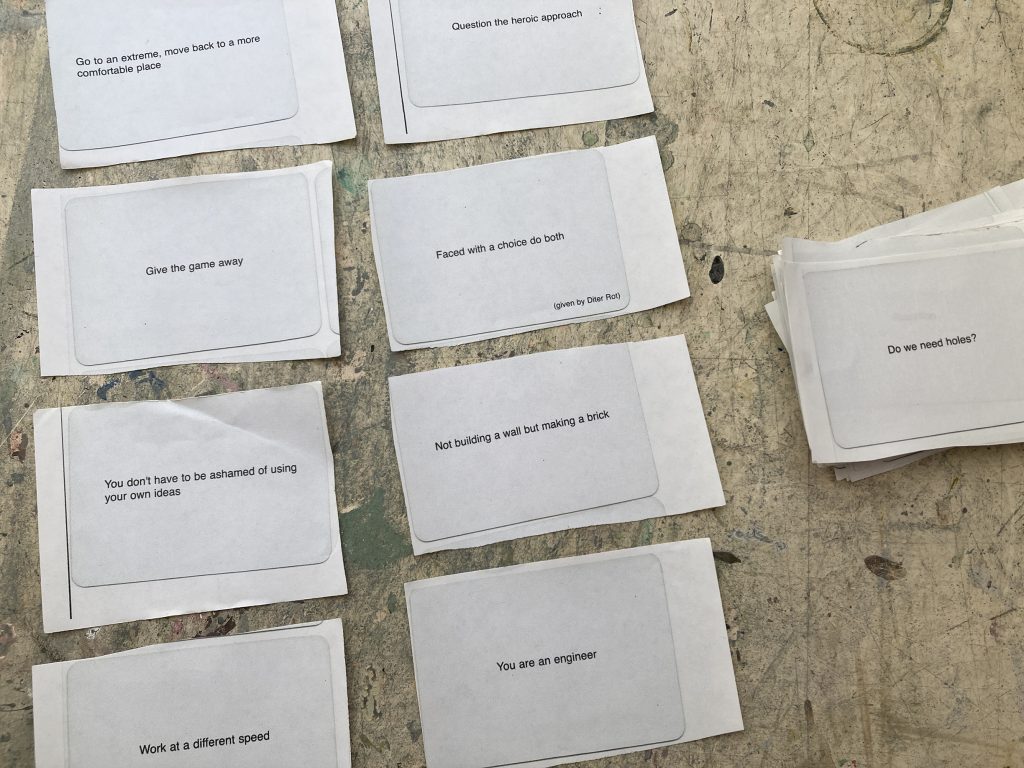
“My worn-out Oblique Strategies deck.”
What images or objects do you look at while you work? Do you have any other artist’s work in your studio? If so, please share a phone pic and tell the story behind it.
Most of the imagery in my work is culled from an amalgamation of personal memories and sourced imagery from books, so I have a lot of books in my studio. They really run the gamut in terms of subject matter, and I love looking at the different titles lined up next to each other. I have many books about home decorating, wallpaper, textile, and furniture design, as well as Pennsylvania Dutch culture and folk art. And then I have a lot of sex books—erotic photography, burlesque, fetish and kink culture, old issues of the late great Math magazine. A lot of these books came from Giovanni’s Room, my favorite gay bookshop in Philadelphia. A title I’m enjoying right now is called From the Tip of the Toes to the Top of the Hose. It’s a collection of images by the foot fetish photographer Elmer Batters. And I have a number of artist books, and monographs, and anatomical texts about the body. I love to see them all hanging out together.
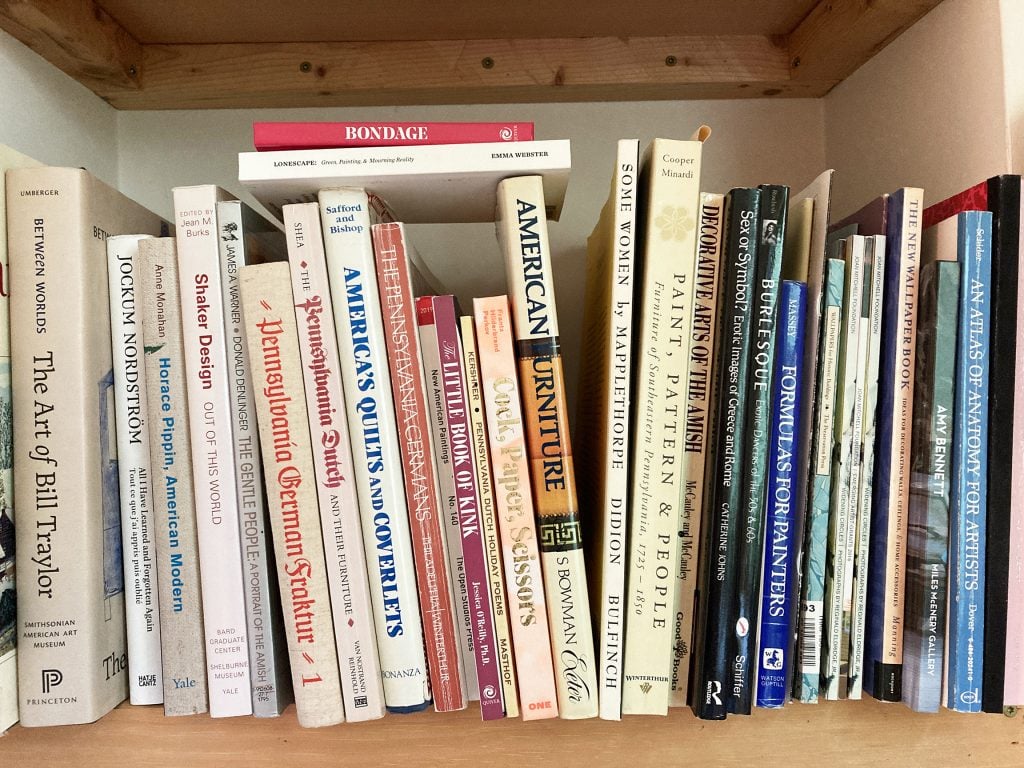
A snapshot of some of Buckwalter’s many books.
What’s the last museum exhibition or gallery show you saw that really affected you and why?
I recently saw Emilie Stark-Menneg’s show at the Bowdoin Art Museum in Brunswick, Maine, and was really into it. The work is rooted in an adaptation of the myth of Daphne and Apollo, which is a story I like to return to. The Bernini sculpture of Apollo pursuing Daphne in the Villa Borghese in Rome is one of the first works of art I saw that moved me to tears. His fingers pressing into her flesh, her arms contorting into knotted tree branches, all of that transformative motion frozen in marble… it absolutely blows my mind. One of Emilie’s sculptures is of Daphne cradling Apollo in a Pietá-like fashion, her tree-branch limbs piercing through his limp body, one twig poking right through his face. I think this is such a smart way to queer the myth—the inversion of power; her penetrating him. I have been ruminating about the value of embracing powerlessness in the body and the ambiguity of desire, and witnessing another artist probing around with similar questions resonated with me.
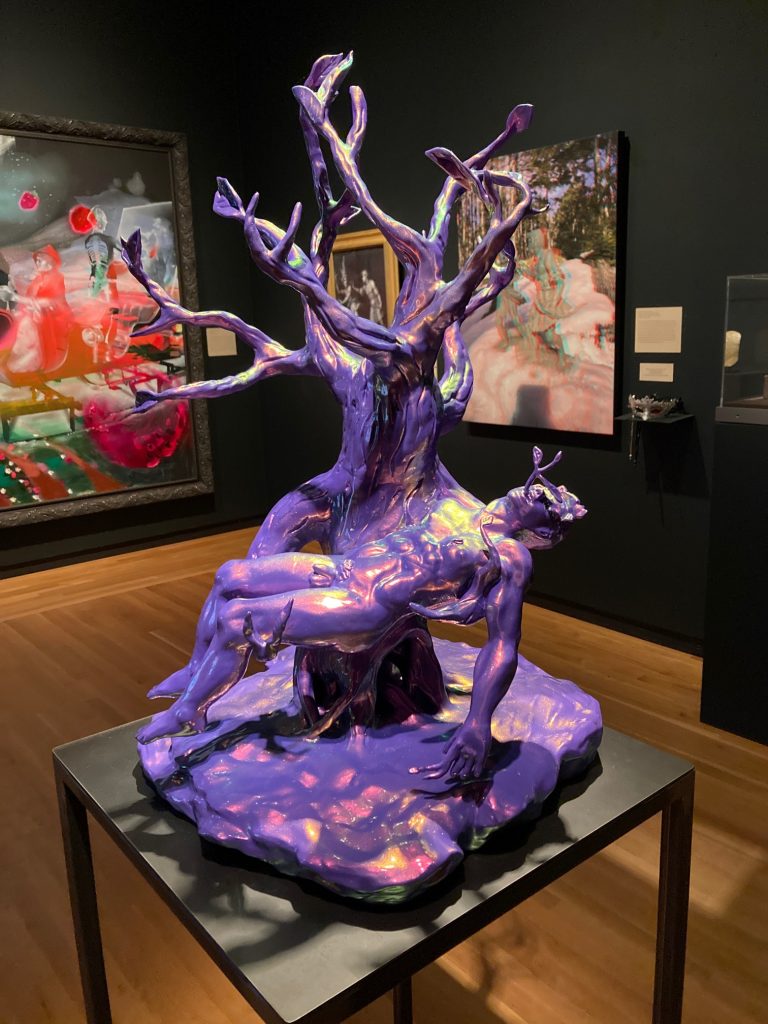
Emilie Stark-Menneg at the Bowdoin College Museum of Art.
Where do you get your food from, or what do you eat when you get hungry in the studio?
It’s peak blueberry season in Maine right now, so my studio breaks often involve going outside barefoot and eating palmfuls of blueberries from the bushes in the garden. Eating something straight from the earth is a consummate pleasure. I also eat a lot of peanut butter pretzels and chocolate chips. And the Paul Newman brand of Oreos, which is another consummate pleasure.
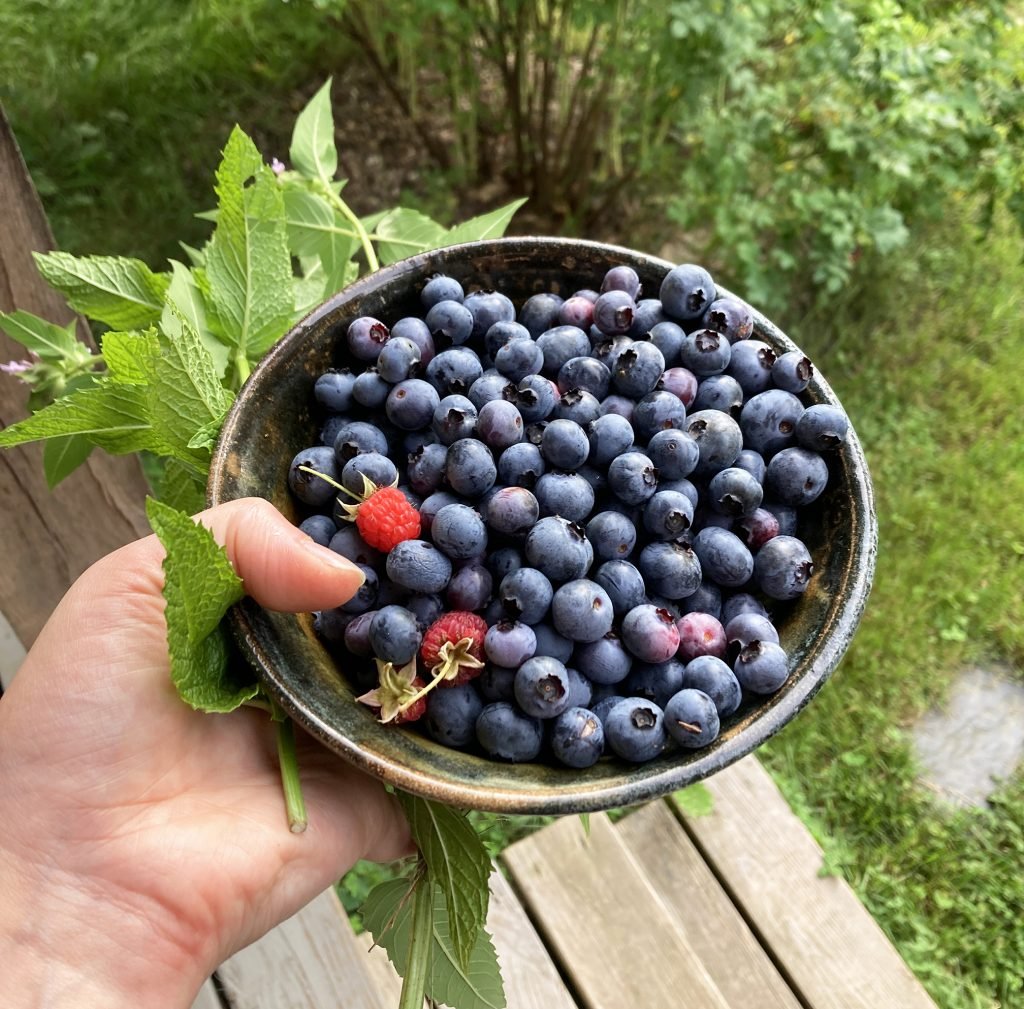
“Blueberries harvested for a studio snack.”
Is there anything in your studio that a visitor might find surprising?
Spiders. There are a lot of them. And yet they surprise me all the time.
What is the fanciest item in your studio? The most humble?
I used to work in a paper conservation lab, which really changed the way I think about the longevity of my paintings. Now I’m kind of obsessed with using nice archival materials for storage and housing. My sweetheart Tim is a woodworker, and one Christmas he built me this epic flat file, so I store works on paper in there with interleaving. I have a bunch of alkaline-buffered corrugated boards that I use to stack and store paintings. It’s fancy stuff, so I don’t use it exclusively, but I try to more or less follow best practices when I can.
And a humble object? My dear friend Jen, who worked with me at the same lab, gave me a mechanical pencil that she labeled with my name on it. I use it constantly.
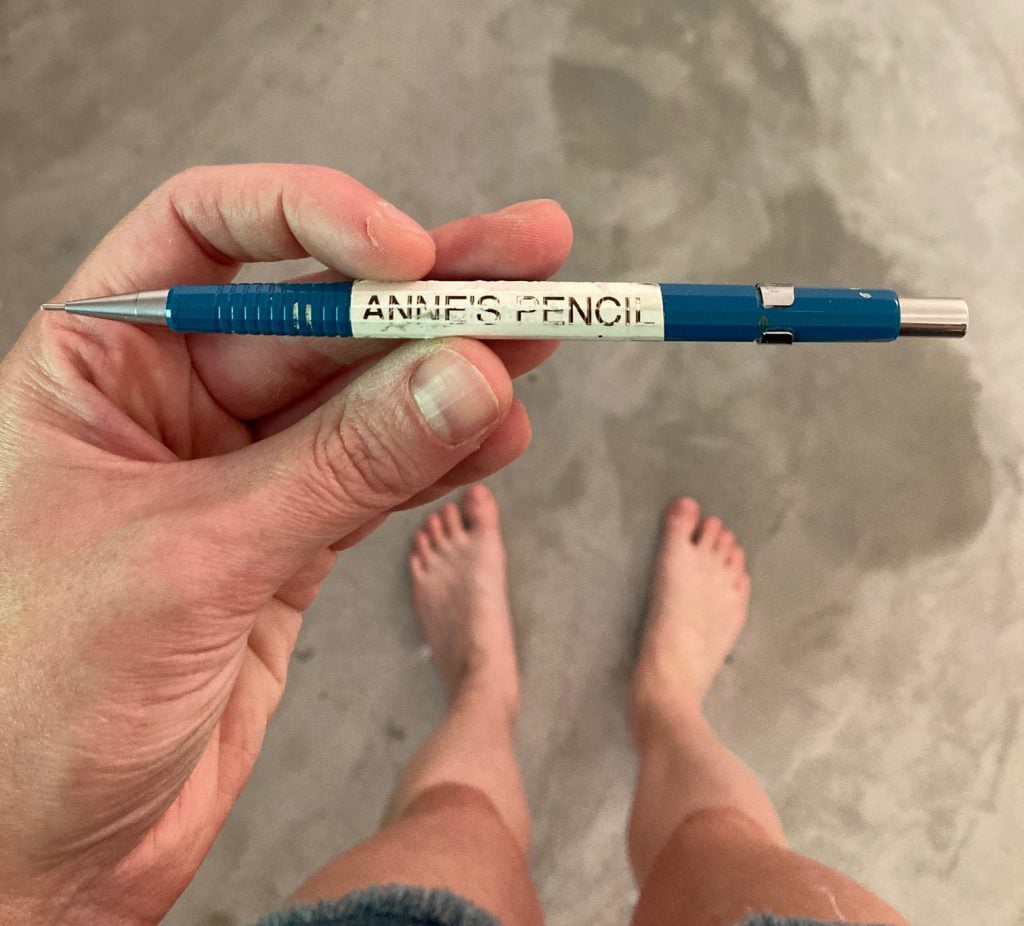
Buckwalter’s Jencil pencil.
How does your studio environment influence the way you work?
Working in the country is new to me, so I’m not totally sure yet, but I’m excited to find out. I can already feel a sense of spaciousness creeping into the work that feels different from when I lived in a city. Right now I am deeply and obsessively weighing questions of scale in my practice: how big to go, and why? What is gained or lost by scaling up? I don’t have answers yet, I’m still experimenting. Since I’m working with the domestic interior as a psychological space, I think being in a remote area also makes me consider the external world in terms of how it mirrors interior realms. The nature I am surrounded by is both quiet and peaceful and chaotic and teeming. The volume of life going on out there is astounding. And it sharpens me in a way, makes me attuned to the wilderness of my mind and body.
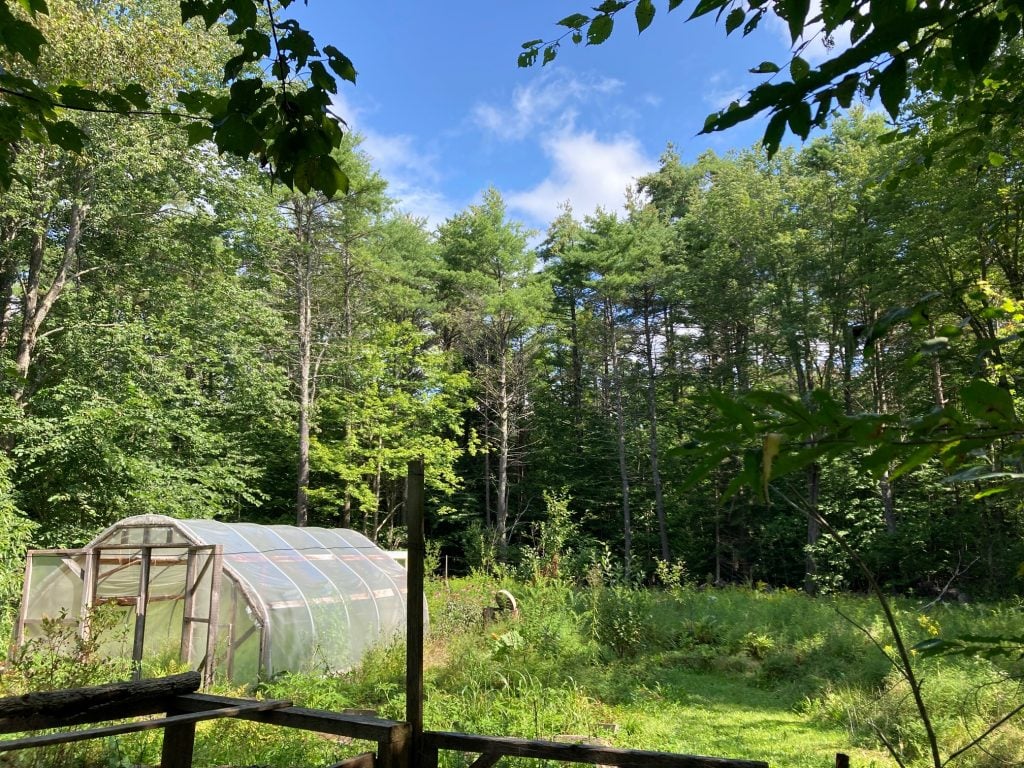
Buckwalter’s yard and greenhouse.
What’s the last thing you do before you leave the studio at the end of the day (besides turning off the lights)?
I wash out my brushes, clean off my palette, and reorganize my paint tubes by color.
What do you like to do right after that?
Find something to eat, go outside, look for toads.
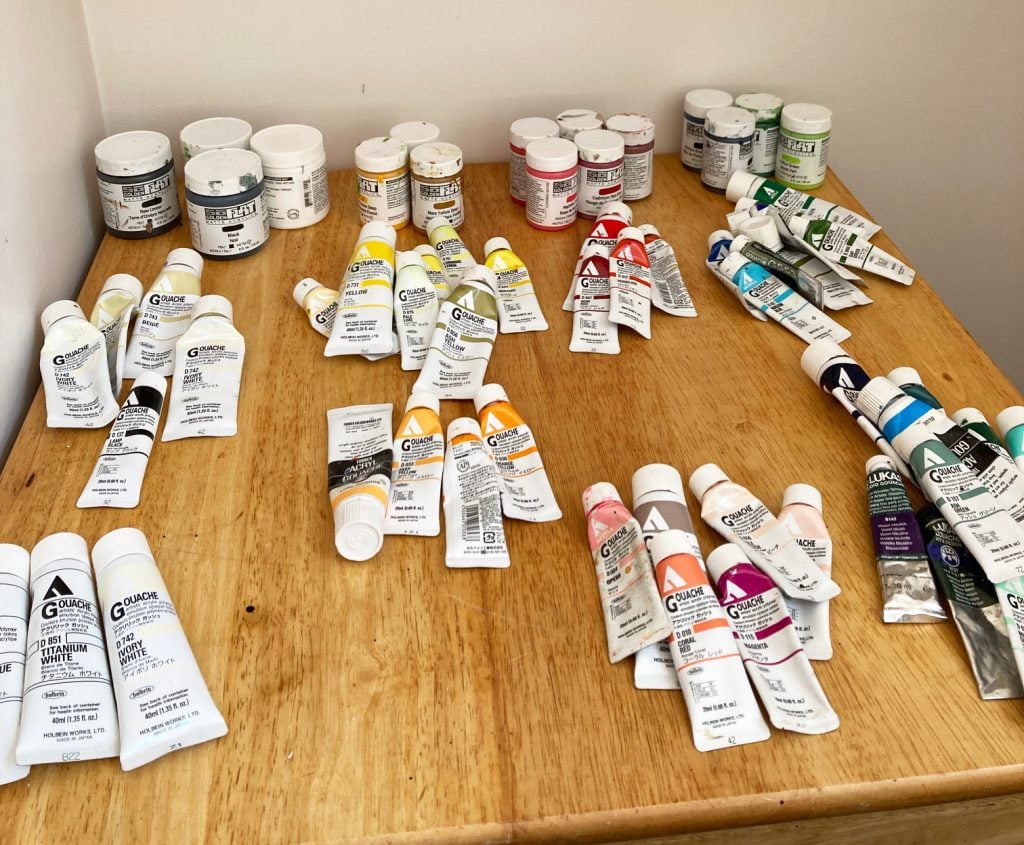
“My paints—mostly Holbein acryla gouache and Golden flat acrylics.”